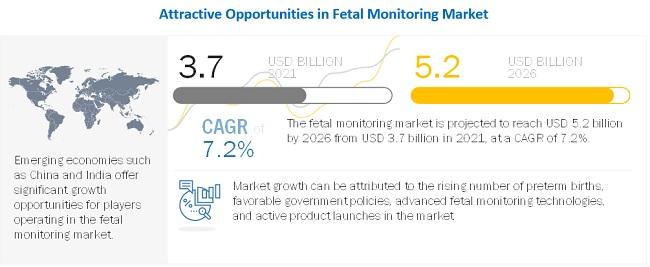The fetal monitoring market is expanding with the latest innovative technologies, backed by escalating research and product launches. Fetal monitoring technologies are now being streamlined to provide greater assistance in utero fetal surgeries, consisting of challenging physical fetal access and technological complications. Fetal cardiac assessments have also witnessed progress that supports high-fidelity hemodynamic and continuous physiologic monitoring, thus enabling early diagnosis and treatment.
Computer-Aided Decision Support Systems and Artificial Intelligence (AI) are also utilized in continuous cardiotocography (CTG) or fetal heart rate (FHR) auscultation during labor. The patient’s electronic health records (EHRs) are utilized along with computational methods, machine learning, and deep learning tools.
Research and technological advancements in fetal monitoring systems have increased focus on noninvasive monitoring procedures. Obstetrics has been introduced with noninvasive diagnosis technologies such as Doppler studies, cell-free fetal DNA assessment, electronic fetal monitoring (EFM), and fetal acid-base status. Fetal and neonatal assessments are carried out during antepartum via percutaneous umbilical cord blood sampling and during intrapartum with fetal scalp blood sampling immediately after birth.
Download PDF Brochure @ https://www.marketsandmarkets.com/pdfdownloadNew.asp?id=35700261
Fetal phonocardiography has been integrated with advanced data acquisition systems and databases. Progressing data analytics, synthetic data generation by advanced mathematical models, and classifications & processing algorithms are under active research & development to increase fetal motoring data processing efficacy.
The advanced technology integrated into fetal monitors comes at a heavy price. Sophisticated monitoring techniques such as Doppler ultrasound machines also incur hefty charges. The probes used in the Doppler technology (for example, the Philips Doppler transducer) range from USD 4,500 to USD 17,000.

[228 Pages Report] The fetal monitoring market is projected to reach USD 5.2 billion by 2026 from USD 3.7 billion in 2021, at a CAGR of 7.2% from 2021 to 2026. The development of noninvasive, portable, and advanced fetal monitors and emerging markets and strengthening infrastructure are expected to offer growth opportunities in the market during the forecast period.
The antepartum segment accounts for the largest share of the market. Antepartum fetal monitoring is carried out throughout the gestation period to diagnose any congenital fetal abnormalities. The extensive monitoring regimes, recent product launches, surging prevalence of fetal anomalies, and maternal mortalities drive the growth of the antepartum segment.
The market is segmented into hospitals, obstetrics & gynecology clinics, and home care settings based on end users. In 2020, hospitals accounted for the largest share of this market. This segment’s growth can be attributed to several factors, such as highly advanced facilities in hospitals and the increasing number of pregnancy procedures.